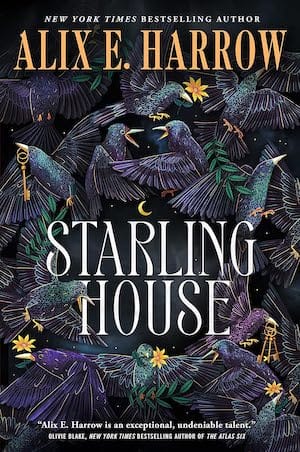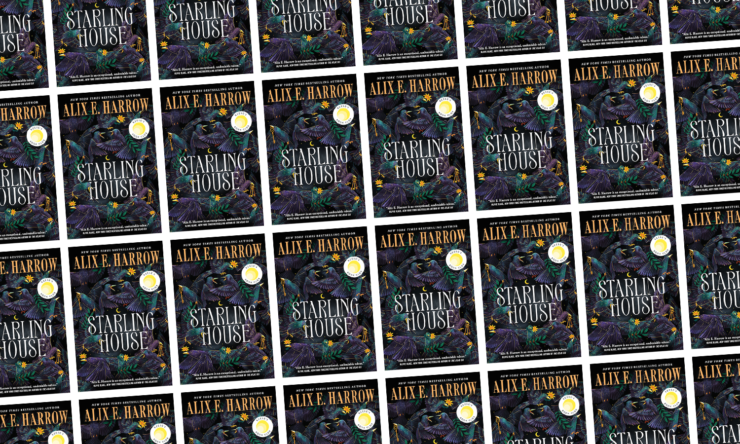It’s an exciting point when a reader can begin to identify common themes and motifs in an author’s body of work. Though I first came to Alix E. Harrow’s writing through the fairy tale remix novella A Spindle Splintered, looking backwards and forwards across her books, patterns emerge. A woman locked away in an old house, escaping through literary portals in The Ten Thousand Doors of January. A coven offering their powers to the suffragette movement in The Once and Future Witches. Sleeping Beauties and Wicked Queens fragmented across retellings. Her latest novel Starling House collects variations on each of these devices, yet despite any familiar glimmers it’s still something wholly new, and undoubtedly her best work yet.
A modern Gothic thriller set in a downtrodden Kentucky coal town, Starling House is satisfyingly creepy while being animated by more than one love story—the one you might expect, between two compelling misfits, but also between a sentient house and its inhabitants. It’s a masterful meditation on the stories that make and unmake us.
Opal dreams of Starling House, the imposing old house calling to her with its warm amber light every night. But unconsciousness is the only time she can give over to such vulnerable yearning; in her waking life, she must look after her asthmatic teenage brother Jasper, working dead-end cashier shifts and engaging in petty thievery in order to get him out of Eden, Kentucky, and into a better life. Only one of them can afford to make it out, and Opal has long since given up on herself.
Buy the Book


Starling House
But the evening that she allows herself to walk past Starling House’s gates, she meets the house’s sole inhabitant, Arthur Starling, who is determined to be the last Warden of Starling House. Until Opal talks her way into a job as housekeeper—for the egregious amount of money Arthur is willing to pay her, of course, but maybe also because she’ll finally get to set foot indoors and scratch her imagination’s itch. What should be a simple job changes the course of Opal’s life, both unspooling a future she never dared imagine for herself as well as unwinding the narrative she’s always believed about her unfortunate life.
The bones of Opal’s story, while initially mundane, have the heft of dark fairy tale: A town, overtaken by a wealthy and powerful clan who have shaped it to their will and collected the fortune in their faraway castles, leaving the actual residents defenseless against the curse they put on the land. A collection of dark fairy tales descending into the Underland, its author long disappeared, either a guide or a warning. Two orphans whose entire world is a motel room, with its transitory guests and permanent water stains, trading a single laptop back and forth into which they try to research their pasts and rewrite their futures. A flame-haired mother, rendered mythical in memory, taken too soon by her unnatural hunger that has left her children starving. A creeping mist that envelops all who encounter it in the kind of ill luck that seems merely cruel in the moment but laughably pathetic in retrospect.
The mist is where things start to get supernatural, though even it could be explained away by the transformation of a land ravaged by coal mining, just like the mineral-heavy air that clogs Jasper’s lungs and the spreading stain over the river that everyone ignores but will never jump into. But then there’s the sentient house. It quickly becomes clear to Opal that Starling House is at least charmingly haunted, and then disturbingly so, and that it has something to do with The Underland, the collection of disturbing fairy tales written by E. Starling, which she hasn’t let herself indulge in since her mother Jewell drove their car into the river and drowned.
Opal is so fixated on snatches of her memory of Jewell that she fails to notice that she has two surrogate mothers in Bev, the surly hotel owner, and Charlotte, an out-of-towner who has temporarily posted up at the local library while researching her book about the dark history of Eden. In fact, there’s a lot that Opal doesn’t know, either because it’s cruelly kept from her or because she simply doesn’t want to acknowledge it.
Harrow excels at a story that enfolds other people’s stories within it; each retelling comes at a key point, and the style in which it is related teaches us something new about Eden and its history, while reflecting the tone and experiences of the teller. To that end, the novel’s footnotes immediately grab the reader’s attention, for how it quickly becomes clear that they are not Opal annotating her own narration, but someone else adding details. My only complaint is that they peter out far too soon; I would have loved for them to remain such a strong dimension throughout the entire book.
There is also, I was delighted to find, a thread of romance glinting through Starling House like a sparkly vein of ore. Opal and Arthur’s dynamic is what I imagine Wuthering Heights to be like, having never actually read the book but having Kate Bush’s ethereal ballad of the same name stuck in my head on repeat while reading: him stalking the limits of Starling House property, punching a pane of glass rather than let her into his heart, and her at the gates shouting it’s me, I’ve come home, I’m so cold, let me in your window.
Dual narration is typical of many romances, but blending first-person and third-person is more unusual. Harrow balances the perspectives with aplomb, with Opal stubbornly narrating every unsavory detail of her life as something of a challenge to the reader, yet clearly missing some key information, versus Arthur’s attempts at emotional distance when relating his own grievous failings as Warden of Starling House. It takes Opal’s prying into his life to spotlight his sacrifices (covering his body with tattooed runes) and his bravery (wielding a sword that isn’t even his birthright), wrenching open a space for forgiveness for both of them.
Though it’s a later-stage reveal, it hopefully isn’t too much of a spoiler to discuss one of the most heart-wrenching aspects of the book: that Starling House calls its Wardens to Eden, offering a home for the homeless. It’s such a poignant twist on the Gothic horror stories in which the reader marvels at why so many people would come to the same haunted house. Maybe in those tales the house is luring victims, but here it’s begging for people to keep the lights on. This unexpectedly emotional dimension amplifies Opal and Arthur’s climactic journey into the Underland, making you care about a couple descending into Hell in a way we haven’t since Orpheus and Eurydice. (Related: Harrow has written an excellent retelling of exactly this in a similar context, though its hopeful ending is painted much bleaker than Starling House’s more tender outcome.)
Harrow writes so stirringly about not just the unexpected joy of finding yourself in a story, but also the terror of it—of being perceived, of someone else layering their own impression upon your narrative, of having to transform from reader to protagonist. What an incredible accomplishment then, to have penned an absorbing book in which so many readers can behold themselves.
Starling House is published by Tor Books.
Read an excerpt.
This book has made Natalie Zutter think very differently about building a house. Share your favorite Gothic riffs with her on Twitter and Bluesky!










